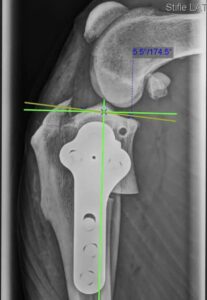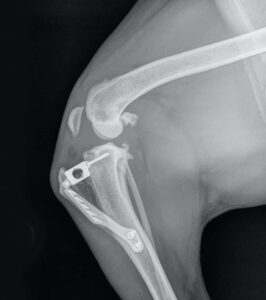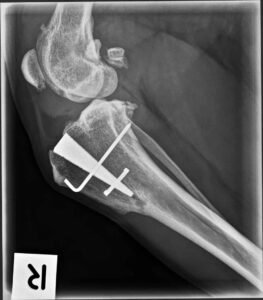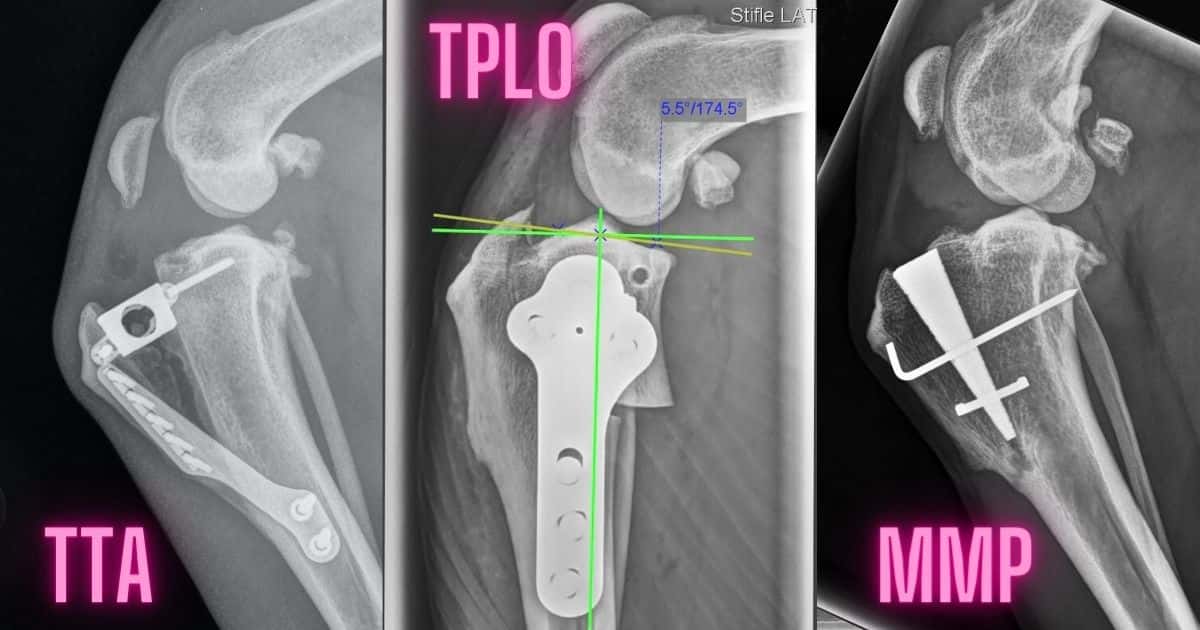Updated July 31, 2023
So your 15kg dog has torn an ACL You know that a lateral suture technique is no good at this size. One vet has told you need an MMP, another a TTA and. third a TPLO.
What do all these random letters mean for your dog? Which one is better?
Here you won’t find an opinion; you’ll find the facts from research papers that compare these cruciate surgery techniques. This is the most-studied surgical procedure in veterinary science.
First, a quick explanation.
The Difference Between TPLO, TTA & MMP

Although they are quite different, each procedure involves the cutting and reshaping of the tibia. This is the shin bone that makes up the bottom half of the knee joint.
The Tibial Plateau Levelling Osteotomy is a curved cut that allows the weight bearing surface of the joint to be rotated from a sloping into a neutral position. The cut is then stabilised with a plate and screws.

The Tibial Tuberosity Advancement moves the attachment of the patellar tendon forward so that it partially offsets the lost force of the cruciate ligament. The advancement is stabilised using a variety of cage-like implants.

Essentially, the Modified Maquet Procedure is a version of the TTA that claims greater stability and simplicity. It uses a titanium foam wedge.
At this point you could well ask, “why so complicated?” Why don’t vets just replace the ligament like in humans?
The answer is that poor outcomes have made vets search for better methods. The De Angelis or lateral suture technique is an older procedure that attempts an artificial ligament, but it has a very high failure rate. We do not use it in dogs above 10kg at Walkerville.
The newer procedures are clearly better. The only question should be: which one is best?
TPLO vs TTA In Dogs
The results of four studies and one large review suggest that the TPLO gives better objective* lameness outcomes with a lower risk of complications. However, TTA gives faster recoveries in the period shortly after surgery.
Here’s what they found:
- Ground reaction forces at a walk for dogs that underwent TPLO normalised between 150 and 299 days after surgery versus more than 300 days after surgery for the TTA
- TPLO achieved normal symmetry indices at a trot after 50 days versus TTA dogs that did not achieve them during the first 12-months
- Dogs receiving TPLO had lower median scores on 14 of 16 canine orthopaedic index inventory items than dogs receiving TTA
- Total, minor, major and catastrophic complication rates were all higher in dogs that underwent TTA than in those that underwent TPLO
- The reoperation rate was higher in dogs that underwent TTA (10.9 per cent) than in those that underwent TPLO (4.8 per cent
- Dogs that underwent TTA were significantly less lame than dogs that underwent TPLO during the early postoperative period
- Osteoarthritis progressed more after TTA, and owners noted less pain and mobility issues long-term (≥3 years) after TPLO
It is essential to stress that although these differences are real, they are not large. All dogs improved substantially, the only difference being by how much. A good TTA performed by an experienced surgeon is almost certainly better than a poor TPLO.
* By objective we mean outcomes where the improvement is measurable and not subject to opinion, such as the amount of weight being placed on the leg.
TPLO vs MMP In Dogs
As the Modified Maquet Procedure is relatively new, there is limited evidence thus far. It is biomechanically comparable to TTA but easier and faster to perform and may provide more stability.
The results of a single comparative study suggest that dogs with TPLO reach a slightly better overall outcome than dogs with MMP. Patients with TPLO reached 84.8% and 89.9% of normal ground reaction forces at 3 and 6 months, versus 79.85% and 84.5% for MMP.
I suspect that in time we will see that the MMP outperforms TTA but we have no evidence thus far to back this up. It should also end up being a cheaper procedure.
Which Is Best: TPLO, TTA or MMP?
Based on the evidence, it is reasonably clear that the TPLO gives better results. Therefore, it should be no surprise that experts in the field overwhelmingly choose the procedure. A survey in 2016 found that 78.6% of respondents from the US Veterinary Orthopedic Society use TPLO.
However, the differences are not great. All three procedures give excellent results, and arguing over which is best is a bit like debating over Apple vs Samsung when your previous phone was a brick.
It’s far more important that you have a trusted vet. I would avoid shopping around if you already have a good relationship. If you choose any of TTA, MMP or TPLO, you are doing an excellent job and your dog will be the winner.
Disclaimer: whichever procedure a vet uses, they tend to sing its praises. I would like to believe I chose TPLO because of the evidence, but it’s possible that this article reflects my bias. I welcome any comments and will do my best to keep the evidence up to date.
You can find the cost for TPLO and De Angelis procedures here.
Click here to learn why dogs tear their ACL.
Have something to add? Comments (if open) will appear within 24 hours.
By Andrew Spanner BVSc(Hons) MVetStud, a vet in Adelaide, Australia. Meet his team here.
References
Knebel, J., Eberle, D., Steigmeier-Raith, S., Reese, S., & Meyer-Lindenberg, A. (2020). Outcome after Tibial Plateau Levelling Osteotomy and Modified Maquet Procedure in Dogs with Cranial Cruciate Ligament Rupture. Veterinary and Comparative Orthopaedics and Traumatology, 33(03), 189-197
Moore, E. V., Weeren, R., & Paek, M. (2020). Extended long‐term radiographic and functional comparison of tibial plateau leveling osteotomy vs tibial tuberosity advancement for cranial cruciate ligament rupture in the dog. Veterinary Surgery, 49(1), 146-154
Von Pfeil, D. J., Kowaleski, M. P., Glassman, M., & Dejardin, L. M. (2018). Results of a survey of Veterinary Orthopedic Society members on the preferred method for treating cranial cruciate ligament rupture in dogs weighing more than 15 kilograms (33 pounds). Journal of the American Veterinary Medical Association, 253(5), 586-597
White, C., & Morrow, L. (2020). Does traditional tibial tuberosity advancement yield similar postoperative outcomes as tibial plateau levelling osteotomy in dogs with cranial cruciate ligament disease?. The Veterinary Record, 187(2), 69-71


My vet recommended MRIT. Can you speak to that?
Hi Susan. In the lack of other evidence, it’s best to assume that this is an analogous procedure to any other lateral capsular technique, such as the DeAngelis procedure.
Hi I’m looking at TPLO versus MMP for my Rottweiler- she is 47kg. Is MMP suitable for this dog?
Our insurance won’t cover the £5.5k for aTPLO but will cover £3k of MMP.
I realise that you are in Australia and we are in uk so just looking for impartial advice.
Thank you.
Hi Linda. The only advice I can give on the two procedures is found in the article. Any extra will just be heresay and potentially misleading. Good luck.
Thanks for explaining the differences in these procedures, as my 4yr old was diagnosed with torn ccl
Thank you for your straightforward explanation! Trying to figure out the differences of each type and what’s best has been overwhelming to say the least. Your article better equips me for our upcoming surgical consult for a ruptured CCL for my 2 yr old lab.